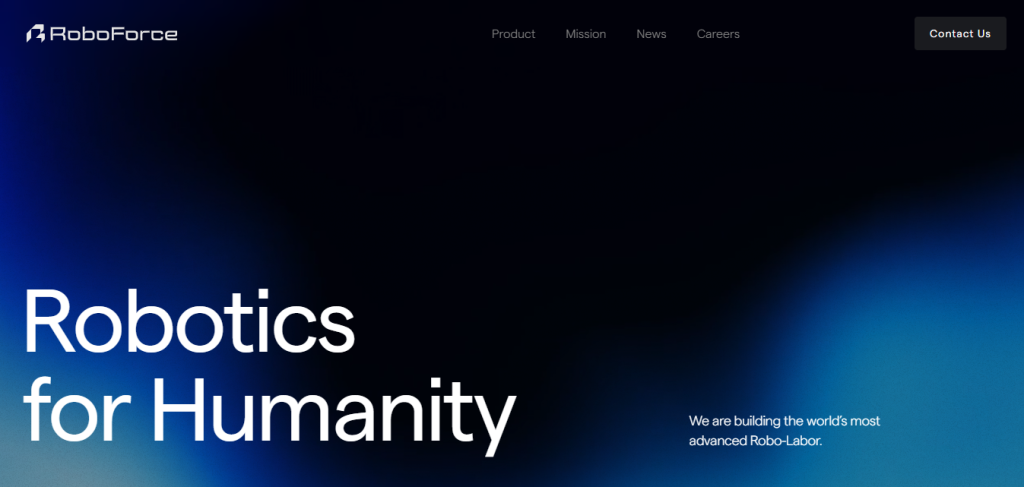RoboForce Raises $5M to Power the Next Generation of Autonomous Robotics
July 14, 2025
byFenoms Startup Research

RoboForce, an emerging leader in autonomous robotic systems, has successfully raised $5 million in a seed funding round, led by undisclosed investors. The raise marks a significant milestone for the company as it sets its sights on redefining how machines operate in complex, real-world environments.
Under the leadership of Leo Ma, RoboForce is developing a new breed of intelligent robots that combine hardware durability with cutting-edge AI to operate autonomously across sectors like logistics, defense, manufacturing, and hazardous operations.
The Future Is Autonomous - and Rugged
RoboForce isn’t just building robots - it’s building resilient, intelligent machines designed for unstructured and dynamic settings. These are not the factory floor bots that have dominated automation for decades. RoboForce systems are engineered to adapt to uncertain terrain, make real-time decisions, and work side-by-side with human operators - whether in a disaster zone or deep in a warehouse.
Their latest prototype features a rugged design with sensor fusion technology, edge processing, and reinforcement learning - all packed into a mobile platform ready for deployment in harsh or high-stakes environments.
Building Autonomy from the Ground Up
Unlike companies that retrofit automation into legacy systems, RoboForce has adopted a ground-up design philosophy. Their robots are purpose-built for autonomy - no remote pilots, no pre-scripted movements. This makes their platform particularly attractive for industries where real-time decision-making, navigation, and environmental perception are critical.
And here’s what makes RoboForce’s approach stand out: most robotics startups begin with narrow use cases - warehouse picking, inspection drones, or cleaning bots. RoboForce, on the other hand, is targeting general-purpose autonomy across multiple verticals from the start. That’s a harder technical challenge, but it also positions them to scale into a wider set of industries once the platform is mature.
The insight for founders here is key: starting with modularity and multi-domain adaptability baked in isn’t scope creep - it’s a strategic hedge against a fragmented robotics market. In autonomy, flexibility isn’t just a product feature - it’s the go-to-market advantage.
Why Autonomous Robotics Is Ripe for Disruption
The robotics market is undergoing a structural shift from task-specific automation to intelligent systems capable of navigating uncertainty. According to MarketsandMarkets, the global autonomous mobile robot (AMR) market is projected to reach $8.7 billion by 2027, growing at a CAGR of over 20.5%. Demand is driven by labor shortages, safety requirements, and the pursuit of continuous operations.
Industrial automation, which used to be limited to repetitive tasks in controlled environments, is now evolving toward AI-driven adaptability. Logistics giants like Amazon, military defense agencies, and energy infrastructure companies are all actively seeking solutions that can operate autonomously under unpredictable conditions.
In parallel, the rise of AI at the edge - where decision-making happens onboard rather than in the cloud - is enabling smarter, faster, and safer robotics systems. RoboForce is tapping directly into this trend, creating self-sufficient machines that don't rely on constant connectivity or human supervision.
What This Funding Round Enables
With the new capital, RoboForce plans to:
- Expand its engineering and AI research teams.
- Accelerate development of its next-gen robotics platform.
- Pilot deployments with industry partners in defense, mining, and logistics.
- Strengthen its manufacturing capabilities to scale production.
The funding will also allow RoboForce to fine-tune its AI algorithms in real-world environments and integrate seamlessly with customer infrastructure - whether that means operating within a security perimeter or mapping an unmapped terrain.
Industry Trends and Competitive Outlook
The robotics space has seen major growth in both funding and adoption. According to Crunchbase, robotics startups raised over $17 billion in 2023, with notable surges in enterprise automation, humanoid robotics, and drone logistics. Companies like Agility Robotics, Boston Dynamics, and ANYbotics continue to draw attention, but smaller, specialized players like RoboForce are capturing the attention of operators looking for flexible and field-ready solutions.
A McKinsey report further estimates that automation could replace tasks accounting for 30% of hours worked across the U.S. economy by 2030. This shift is accelerating demand for robotic platforms that aren’t just smart - but adaptive, resilient, and easy to integrate.
For investors and enterprise buyers, the value is clear: automation increases throughput, reduces downtime, and enables predictive maintenance - all of which tie directly to bottom-line growth.
What’s Next for RoboForce?
In the coming months, RoboForce is expected to announce new partnerships with enterprise clients and possibly a first deployment with defense or industrial partners. With $5M now secured, the company is poised to turn its vision into reality - one robot at a time.
If successful, RoboForce won’t just be building autonomous robots - they’ll be building trust in autonomy itself.









